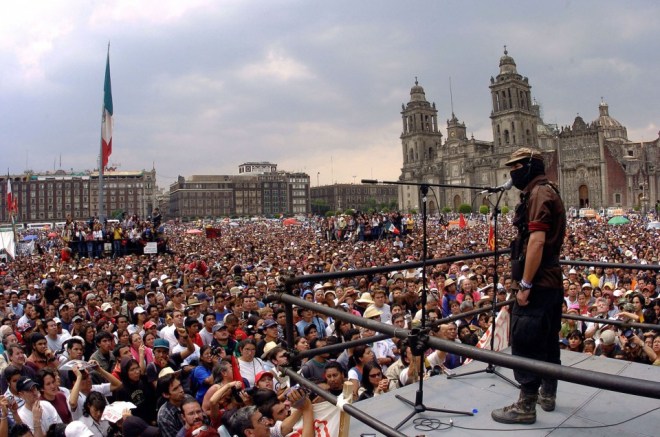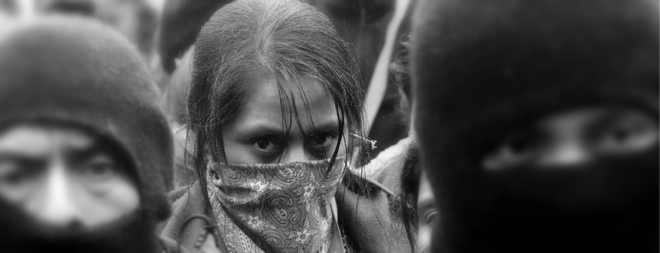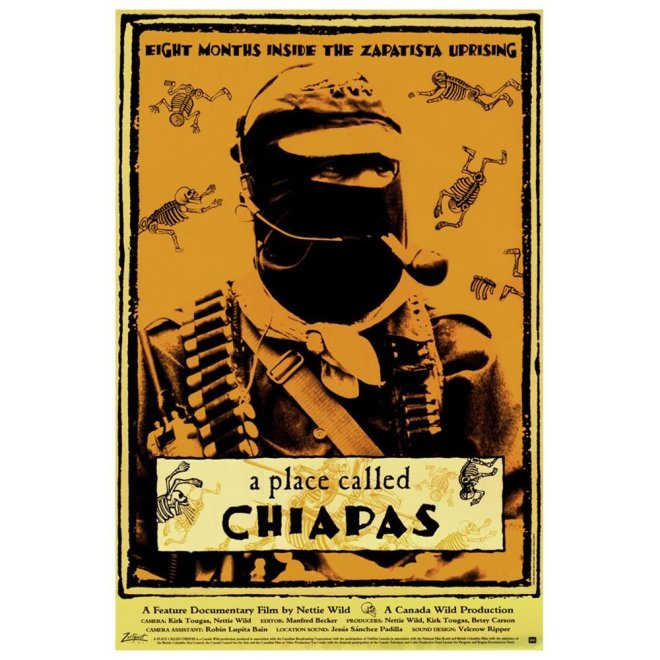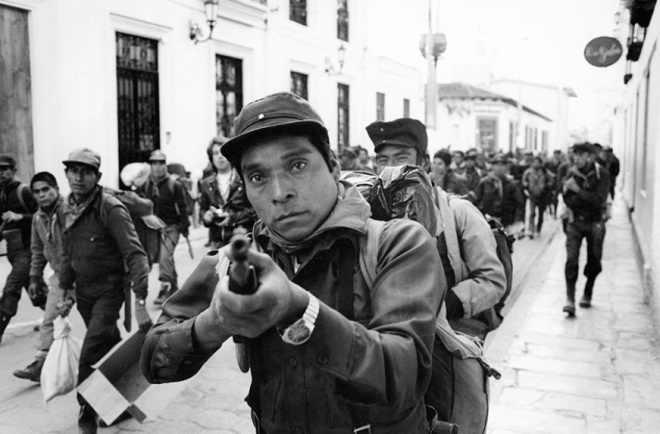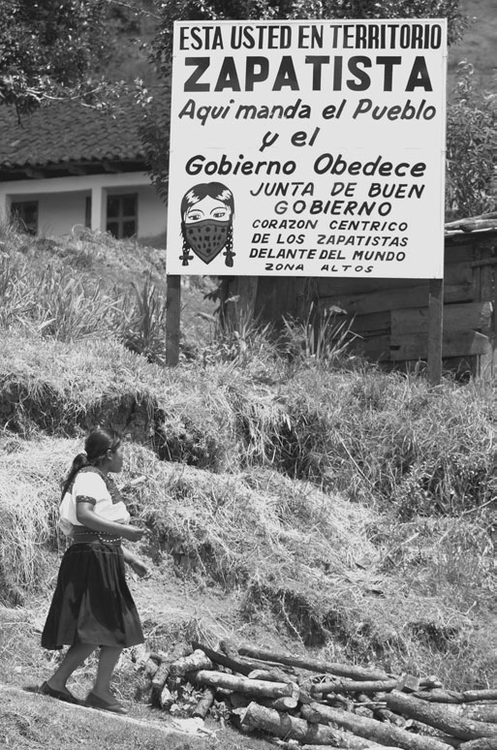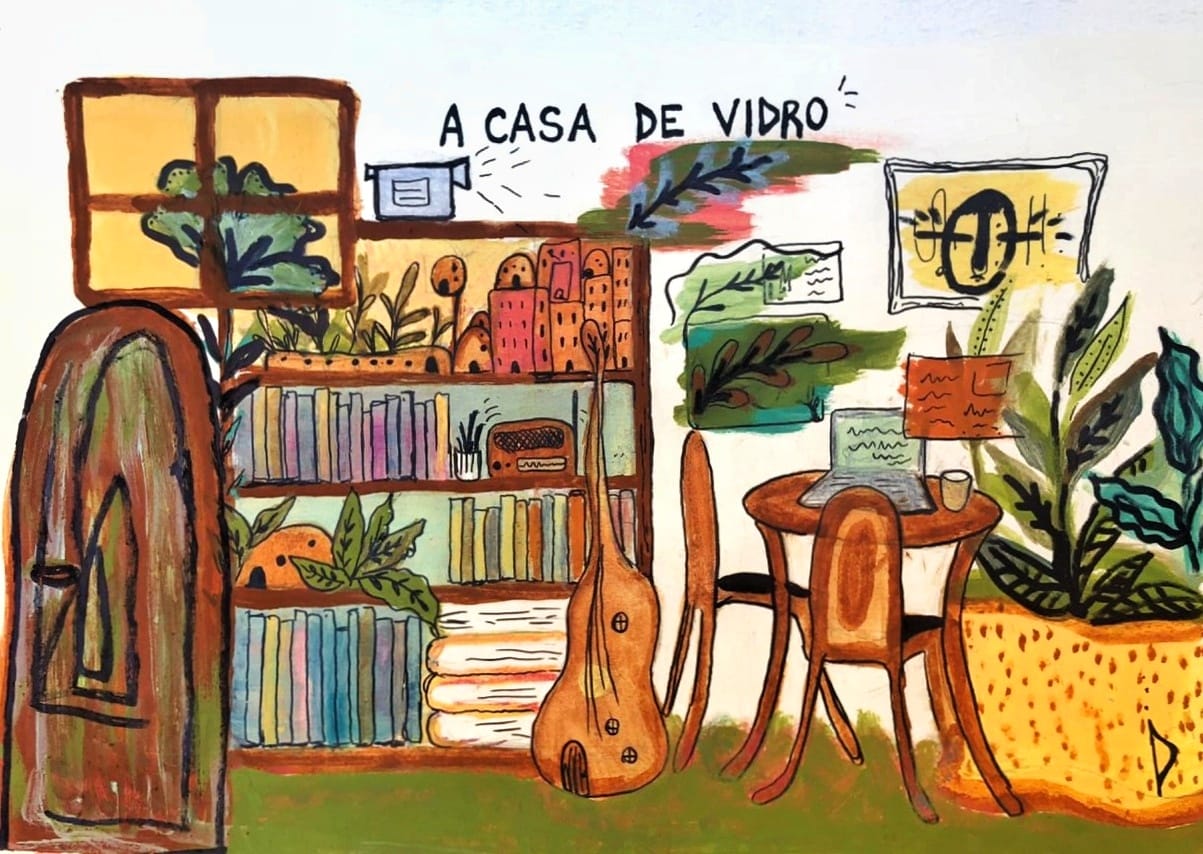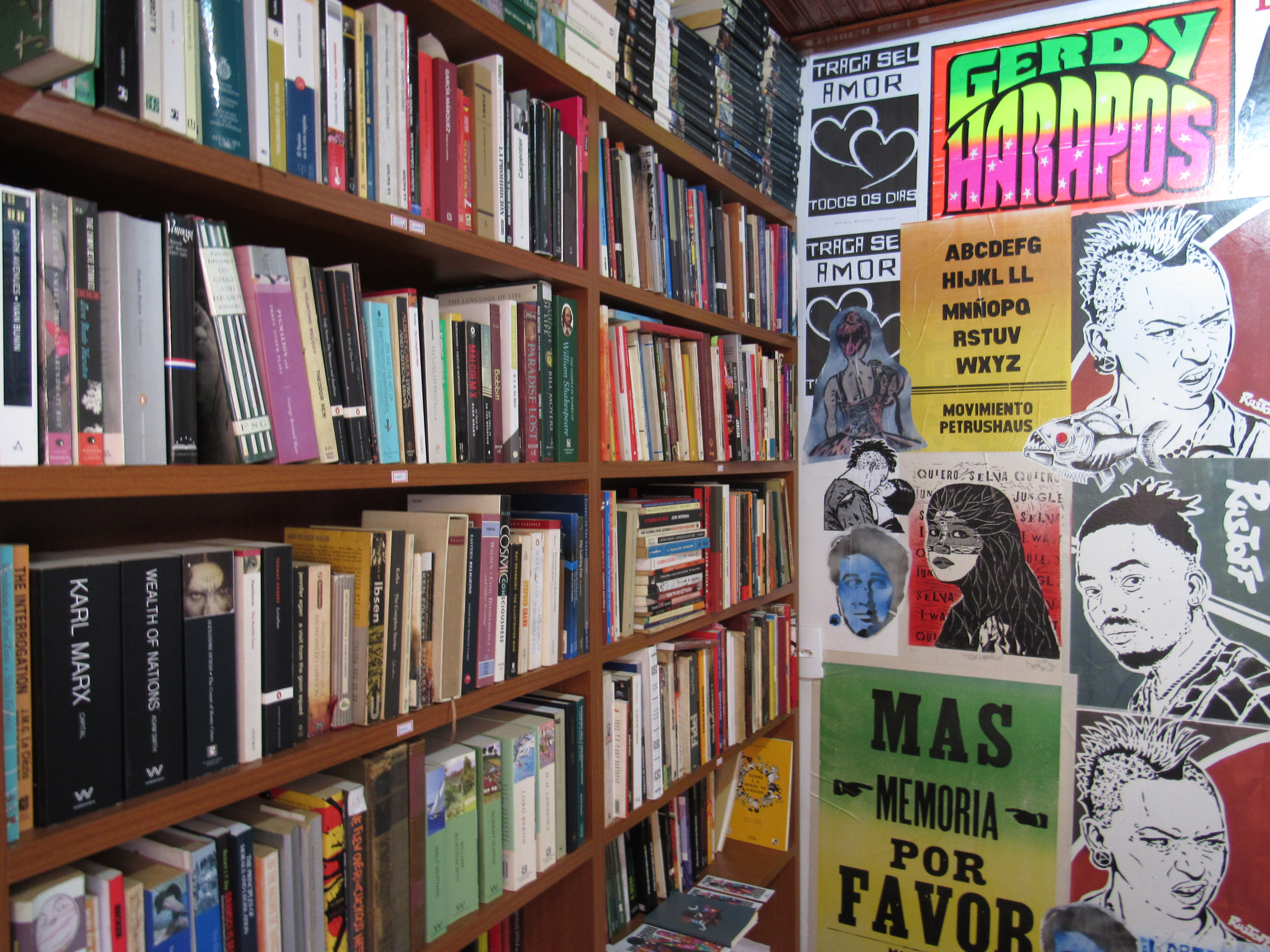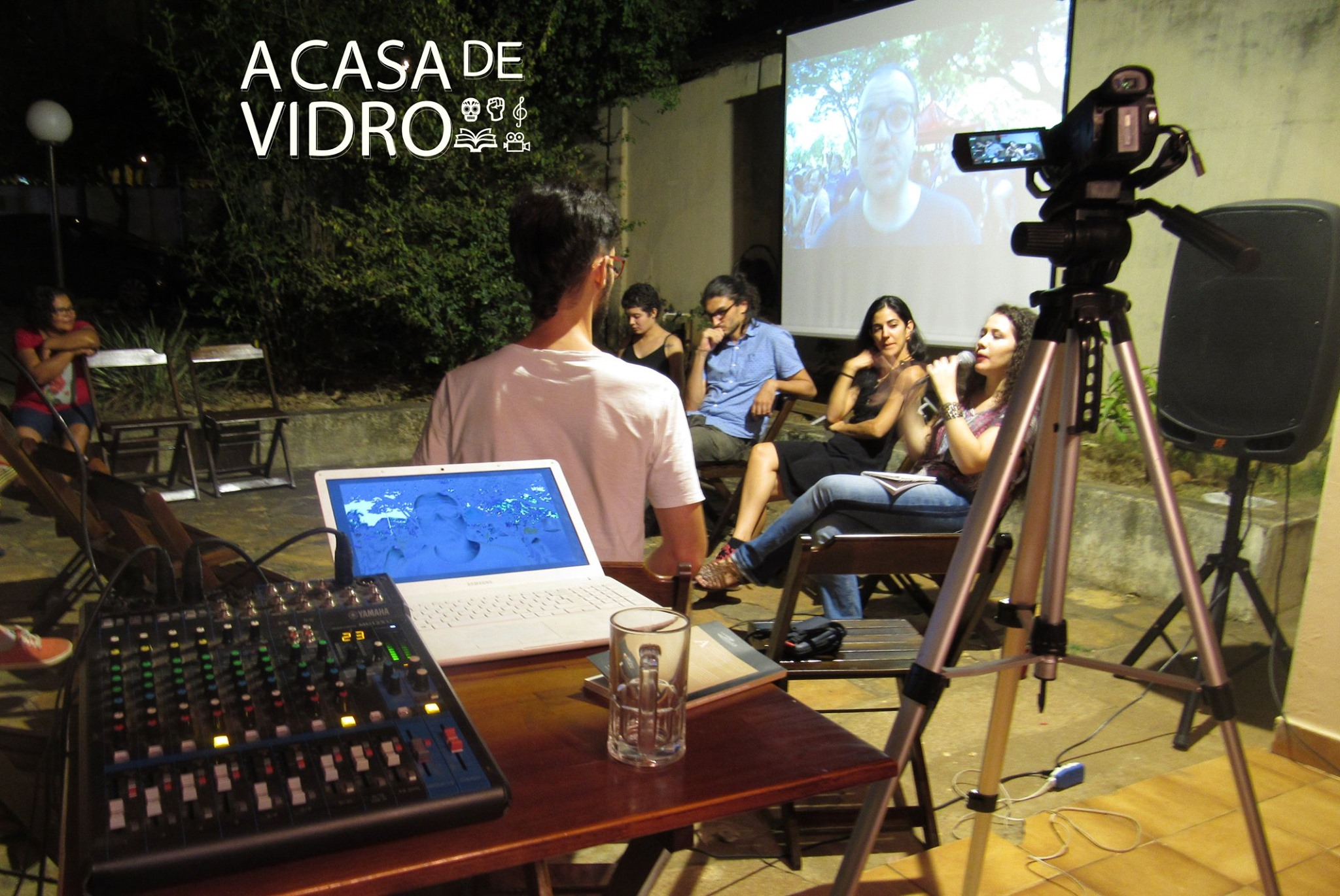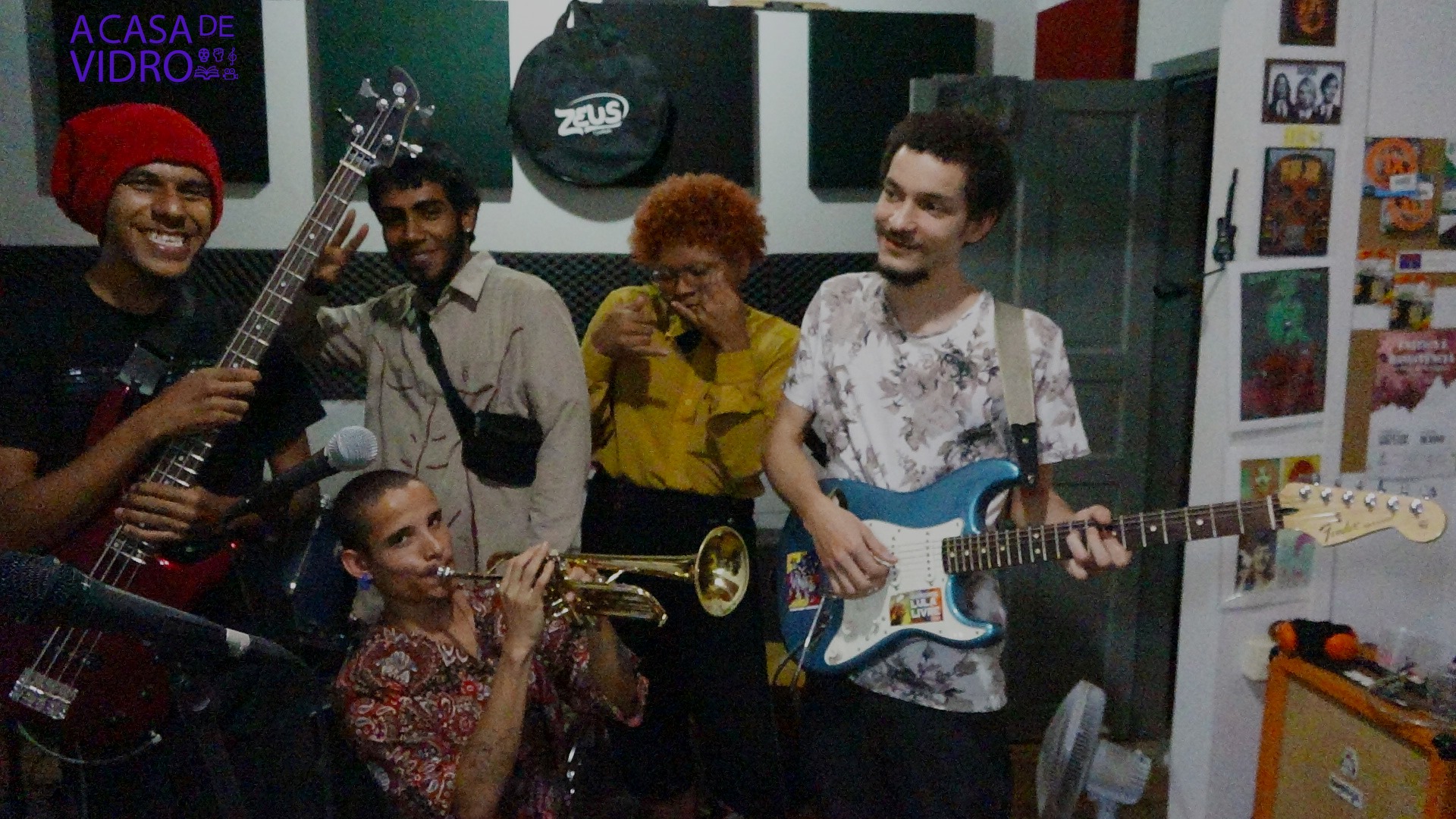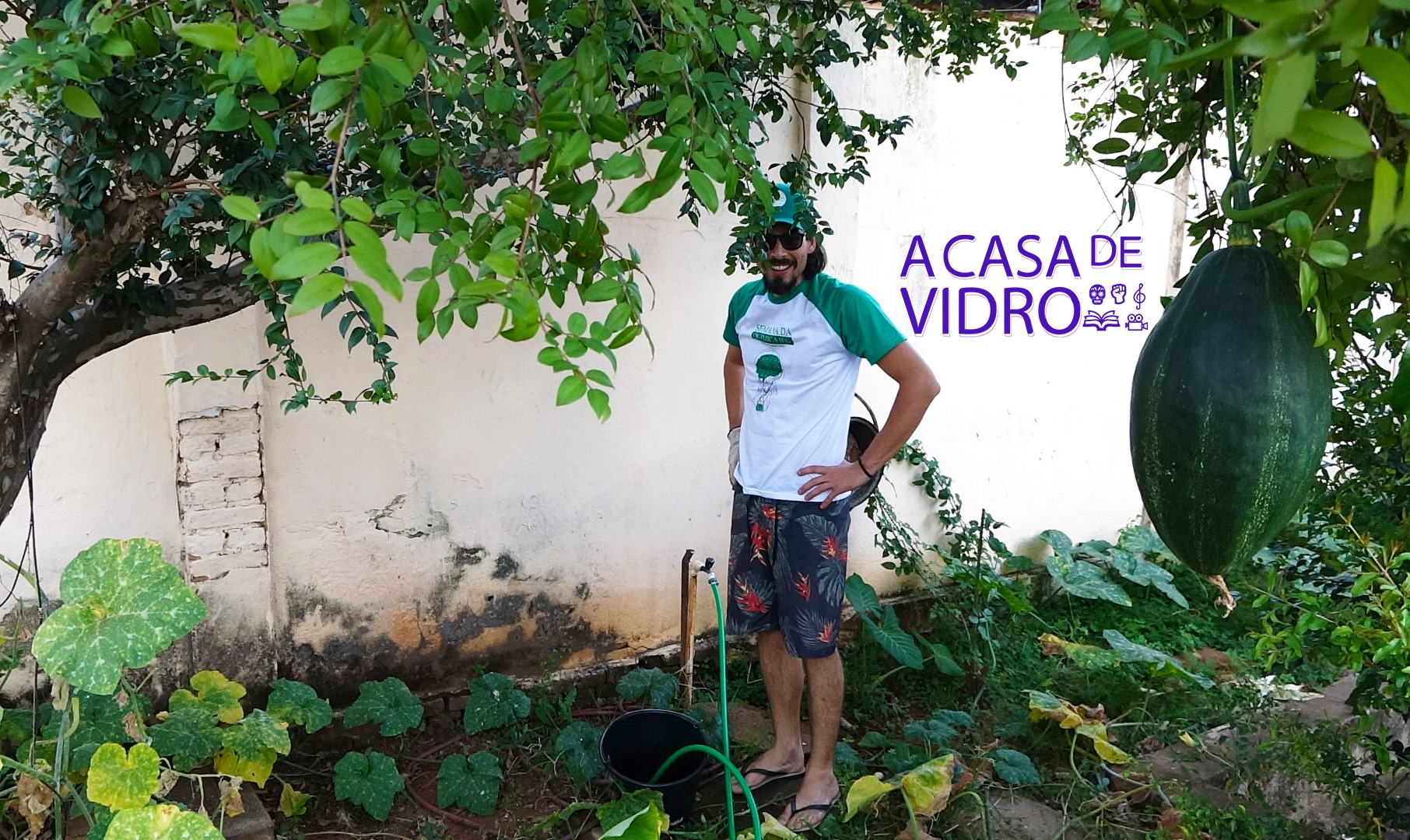“Raízes e Frutos da Rebelião” – Comentários sobre a luta dos Zapatistas mexicanos contra o Capitalismo Neoliberal
“To kill oblivion with a little memory,
we cover our chests with lead and hope.”
SUBCOMANDANTE MARCOS,
Ejército Zapatista de Liberación Nacional (EZLN).
In: ‘Our Word is Our Weapon: Selected Writings’,
Foreword: José Saramago (Nobel Prize In Literature)
Published by Seven Stories Press (New York, 2003, Pg. 100.)
PART I – THE BIG-BELLIED BEAST
AGAINST THE GRASS-ROOTS RESISTANCE
CHAPTER I – CHIAPAS LOSES BLOOD THROUGH MANY VEINS
“We are a product of 500 years of struggle: first, led by insurgents against slavery during the War of Independence with Spain; then to avoid being absorbed by North American imperialism; then to proclaim our constitution and expel the French empire from our soil; later when the people rebelled against Porfirio Diaz’s dictatorship, which denied us the just application of the reform laws, and leaders like Villa and Zapata emerged…” – First Declaration of the Lacandon Jungle, January 2, 1994
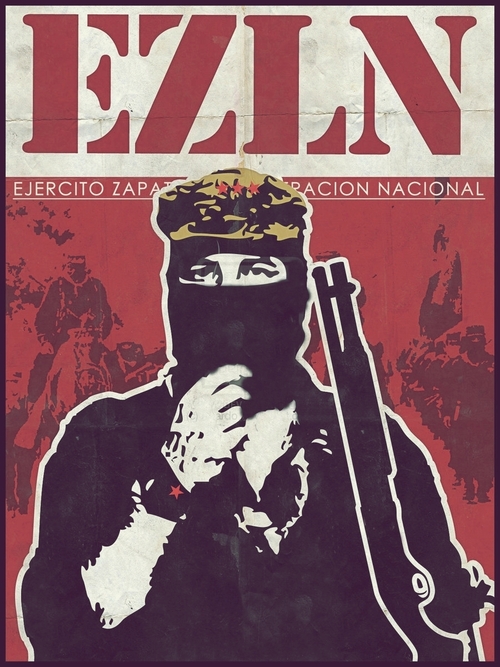 In the mountains and jungles of the Mexican southeast, an insurrection explodes in January 1st, 1994. Several municipalities in the province of Chiapas are taken over by the armed rebels that call themselves Zapatistas, followers of the legacy of Mexican revolutionary Emiliano Zapata (1879-1919).
In the mountains and jungles of the Mexican southeast, an insurrection explodes in January 1st, 1994. Several municipalities in the province of Chiapas are taken over by the armed rebels that call themselves Zapatistas, followers of the legacy of Mexican revolutionary Emiliano Zapata (1879-1919).
Led by the campesinos and the indigenous populations of Chiapas, this neo-zapatist movement blossoms into the spotlight of the world’s arena in exactly the same day of the implementation of NAFTA, the Free Trade Agreement of the North American countries.
From day one, it was made quite clear by the rebels that one of the objectives of EZLN’s uprising was to be an obstacle to the implementation of Free Trade policies in Mexico. The economical set-up of Neoliberalism (based on privatization, free competition, consumerism etc.), argues the Zapatistas, is nothing but an authoritarian imposition of rules made-up by “the world of money”:
“The world of money, their world, governs from the stock exchanges. Today, speculation is the principal source of enrichment, and at the same time the best demonstration of the atrophy of our capacity to work. Work is no longer necessary in order to produce wealth; now all that is needed is speculation. Crimes and wars are carried out so that the global stock exchanges may be pillaged by one or the other. Meanwhile, millions of women, millions of youths, millions of indegenous, millions of homosexuals, millions of human beings of all races and colors, participate in the financial markets only as a devalued currency, always worth less and less, the currency of their blood turning a profit. The globalization of markets erases borders for speculation and crime and multiplies borders for human beings. Countries are obliged to erase their national border for money too circulate, but to multiply their internal borders.” – (Marcos, Unveiling Mexico, p. 117)
Wall Street and Washington join hands and try to persuade Mexicans that “Free Trade” will be a marvel for Mexico, but Mexicans have every reason to be suspicious of their neighbor who stole from it a big slice of territory in bygone years. Today, at the frontier that separates the countries, the yankees have built up a huge Wall of Segregation, and soldiers with license to kill can deal with illegal immigrants in very unbrotherly ways. The same country responsible for La Migra (and Guantánamo Bay, and Abu Ghraib detention facility…) preaches the Free Trade gospel as if it was salvation.
The men and women who have arisen to speak out their discontent in Chiapas are yet to be fully heard by the world-at-large. Artists and writers have helped spread their voices, from Manu Chao and Rage Against the Machine, to José Saramago and Eduardo Galeano. 20 years later, the Zapatistas are still struggling against the powers that want to crush human dignity in the bloody altars of profit. And if the Zapatistas’ scream has the potentiality to be heard and comprehended all around the world, it’s because they accuse the established capitalist system of committing crimes that are visible worldwide, in many different countries: ecological devastation; ethnical genocide of indigenous populations and destruction of their cultures; concentration of capital in the hands of a few multinational corporations etc.
Zapatismo has been called the first revolutionary movement of the Internet-era, the avant-garde guerrilla that’s pioneering the ways to be followed by the guerrillas of tomorrow. But reactionary political powers have been violently trying to silence their voices – and the “money world”, also referred to by Marcos as “The Beast”, doesn’t refrain from methods such as military agression, police repression, institutionalized murder, and para-military militias. All in order to maintain the Order imposed by The World of Money and to bury the voices of these “indians”, covered in masks and carrying guns, that insist in demanding social justice, autonomy and real democracy.
Marcos describes Chiapas’s tragedies very vividly in his poetry-filled words: “This land continues to pay tribute to the imperialists”, writes the insurgent Zapatista, “and there’s a thousand teeth sunk into the throat of the Mexican Southeast” (Unveiling Mexico, 1992, pg. 22-23). Would the indigenous populations of southeast Mexico have risen in rebellion if the suffering they endured hadn’t become unbearable?
“In times past, wood, fruits, animals, and men went to the metropolis through the veins of exploitation, just as they do today. Like the banana republics, but at the peak of neoliberalism and ‘libertarian revolutions’, the Southeast of Mexico continues to export raw materials, just as it did 500 years ago. It continues to import capitalism’s principal product: death and misery.
The health conditions of the people of Chiapas are a clear example of the capitalist imprint: 1.5 million people have no medical services at their disposal. There are 0,2 clinics for every 1.000 inhabitants, 1/5 of the national average. There are 0,3 hospital beds for every 1.000 Chiapanecos, 1/3 the amount in the rest of Mexico… Health and nutrition go hand in hand with poverty. 54% of the population of Chiapas suffers from malnutrition, and in the highlands and forest this percentage increases to 80%…. This is what capitalism leaves as payment for everything that it takes away. (…) Chiapa’s experience of exploitation goes back for centuries. ” – Sub Marcos, Unveiling Mexico
In Subcomandante Marcos’ political tought, which seems to be deeply rooted in an understanding of Latin America’s reality similar to Eduardo Galeano’s, Imperialism is the name of the beast which has it’s thousands of teeths sunk into Chiapas neck – and so many numberless others places on this Earth where 85 flesh-and-blood earthlings retain the same amount of wealth as half of the world’s population (according to Oxfam). Welcome to the established economical and political orden in 3rd planet from the Sun, a place of extreme inequality in which the criminal status quo is defended by armies and warmongers, for the profit of speculators, gangsters and banksters.
“A handful of businesses – one of which is the Mexican state – take all the wealth out of Chiapas and in exchange leave behind their mortal and pestilent mark..(…) Pemex has 86 teeth sunk into the townships of Estación Juárez, Reforma, Ostuacán, Pichucalco, and Ocosingo. Every day they suck out 92.000 barrels of oil and 517.000.000.000 cubic feet of gas. They take away the petroleum”, states Marcos, “and in exchange leave behind the mark of capitalism: ecological destruction, agricultural plunder, hyperinflation, alcoholism, prostitution, and poverty.”
It’s easy to delineate the image of the Enemy in the Zapatistas’ hearts: the face of the big-bellied beast of Greed. Imperialism is dirty business, greediness in action, devastating egotism that turns nations into vampires that suck the life-blood of others. Besides the petroleum that gets sucked out of Chiapas by greedy oil companies, another similar process affects the production of coffee: 35% of Mexico’s coffee is produced in Chiapas, but more than 50% of Chiapas’ coffee production is exported. The campesinos that work in the fields to produce it have terribly inadequate life-conditions of nourishment, health, education etc. The true producers are dying of hunger and disease while foreign powers ride on golden streets of robbed privilege.
The list can be enriched with many other “commodities” that are sucked-out of Chiapas to feed, elsewhere, the belly of the beast. There are 3.000.000 animals waiting to be slaughtered for beef in Chiapas: “the cattle are sold for 400 pesos per kilo by the poor farmers and resold by the middlemen and businessmen for up to 10 times the price they paid for them.” (Unveiling Mexico, p. 23) Chiapas’ forests are also among the culinary preferences of the greedy hungry beast: whole woods are cut down by capitalism’s chainsaws, and this precious wood is then shipped out of Chiapas to be sold elsewhere for huge profits. Similar histories could be told about honey, corn or hydrelectric energy – goods that Chiapas produces in large quantities, but get eaten away by this beastly creature which Marcos denounces and summons to answer: “what does the beast leave behind in exchange for all it takes away?” (pg. 24)
[youtube id=http://youtu.be/4TffwElt_UU]
* * * * *
CHAPTER II – THE TIME TO HARVEST REBELLION INSTEAD OF DEATH
John Lennon asked us in his era-defining song to “imagine a brotherhood of man”, but Chiapas isn’t the place to look for it. It ain’t brotherly treatment to exploit, repress and steal fellow humans – and that’s what businessmen and fancy capitalists have been doing against the Chiapanecos. “1.000.000 indigenous people live in these lands and share a disorienting nightmare with mestizos and ladinos: their only option, 500 years after the “Meeting of Two Worlds”, is to die of poverty or repression.” (Marcos: p. 26)
There are 300.000 Tzotziles, 120.000 Choles, 90.000 Zoques, and 70.000 Tojoales, among other indigenous populations, that inhabit the land of the poorest state in Mexico. Chiapas could be rich, but it’s wealth is sucked away and taken abroad, to bank accounts of greedy capitalists, and if you join the Zapatista up-rising against this reality you might end up killed by the repression. How many people has the Mexican Army killed in order to silence the voices that question the undoubtable goodness of the so-called “Free Market”? I leave the question unanswered, for now, and move on, from exploitation to rebellion.
At the dawn of the New Year, in January 1st 1994, the Zapatista National Liberation Army descended from the Lacandon Jungle to take over the power in several cities of Chiapas, including San Cristobal de Las Casas and Ocosingo. They believed to be “professionals of hope”, “transgressors of injustice”, “History’s dispossessed”, finally raising their voices to demand liberty, justice, democracy, dignity. This is the moment when they became visible, when they stepped out of the shadows, when they shouted for the whole World to hear.
“Death does not hurt; what hurts is to be forgotten. We discovered then that we longer existed, that those who govern had forgotten about us in their euphoria of statistics and growth rates. A country that forgets itself is a sad country. A country that forgets its past cannot have a future. And so we took up arms and went into the cities, where we were considered animals. We went and told the powerful: “We are here!” And to the whole country we shouted: “We are here!” And to all the world we yelled, “We are here!”…”
This movement is deeply rooted in History: far from being immediatist and pragmatic, the Zapatista movement demands respect for the rights of human populations who descend from the occupants of this land prior to the European’s invasion. This scream of rebellion raises from an ocean of blood: the genocide of the Indians and the destruction of their civilizations is still an open wound in the Zapatistas hearts, and they won’t allow the world to forget these past misdeeds. In January 1994, Subcomandante Insurgent Marcos reminded us than in Mexico
“during these past ten years (1984-1994), more than 150.000 indigenous have died of curable diseases. The federal, state, and municipal governments and their economic and social programs do not take into account any real solution to our problems; they limit themselves to giving us charity every time elections roll around. Charity resolves nothing but for the moment, and again death visits our homes. That is why we think no, no more; enough dying this useless death; it is better to fight for change. If we die now, it will not be with shame but with dignity, like our ancestors. We are ready to die, 150.000 more if necessary, so that our people awaken from this dream of deceit that holds us hostage.” (pg. 17)
Seen from the capitalists’ perspective, there’s a dispensable strata of the population labeled as “Indians” (so called because Columbus thought, more than 500 years ago, that the land where he had arrived was India…). “Check out the text of the Free Trade Agreement, and you will find that, for this government, the indigenous do not exist.” (p. 66) Social inequality and marginalized people go hand in hand in Mexico: “on a national level there are 2,403 municipalities. Of these, 1.153 have a level of marginalization considered high or very high. States with high indigenous population have the majority of their municipalities with high and very high levels of marginalization: 94 out of 111 in Chiapas; 59 out of 75 in Guerrero; 431 of 570 in Oaxaca…” (p. 67)
For 10 years the Zapatista uprising had been fermenting in the woods, since 1984, and at the beginning of 1994 time had arrived for their voice to be heard, not only in Mexico, but throughout the world, amplified by the Internet, sending its shout throughout the Global Village. One of the easiest ways to understand the emergence of Neo-Zapatism is to look at the consequences of the NAFTA (North American Free Trade Agreement) agreement becoming active: free market had kicked out the barriers and products from abroad were about to flood into Mexico, like a tsunami, drowning out Mexican campesinos with the devastating power of a Dust Bowl Storm. The Zapatistas knew very well that NAFTA would certainly enrich some big corporations, mainly american and canadian, but would wreck the equilibrium of the local economies – especially in southeast Mexico. NAFTA was inforced with “dictatorial” fashion: it’s a fact that neither civil society nor the indigenous populations of Mexico were consulted on the matter, even tough they would be tremendously affected by the transformations in the National Constitution.
“The preparations for NAFTA included cancellation of Article 27 of Mexico’s constitution, the cornerstone of Emiliano Zapata‘s revolution of 1910–1919. Under the historic Article 27, Indian communal landholdings were protected from sale or privatization. However, this barrier to investment was incompatible with NAFTA. With the removal of Article 27, Indian farmers feared the loss of their remaining lands, and also feared cheap imports (substitutes) from the US. Thus, the Zapatistas labeled NAFTA as a “death sentence” to Indian communities all over Mexico. Then EZLNdeclared war on the Mexican state on January 1, 1994, the day NAFTA came into force.” – Wikipédia
According to Marcos, NAFTA “only means freedom for the powerful to rob, and freedom for the dispossessed to live in misery.” (p. 73) We’ve heard this real-life story many times: everytime a Wal-Mart opens in a city, lots of smaller stores go bankrupt because they can’t compete with Wal-Mart’s prices. That’s why it’s possible to considerer EZLN as a movement demanding national sovereignty; from the Zapatistas perspective – which arises from the experience of thousands of Mexicans – what is called “neoliberalism” is just a fancy name for imperialist capitalism, for foreign domination, for the sad reality known for centuries in Latin America of wealth being robbed from a country and getting transformed in capital that enriches some big-shot abroad.
In Ana Carrigan’s excellent article “Chiapas: The First Postmodern Revolution”, she reminds us that years before NAFTA forced itself into North America there was already a lot of rebellion by campesinos in Mexico: in April 10, 1992, for example, 4.000 indigenous campesinos marched to the country’s capital and read a letter adressed to President Carlos Salinas, in which “they accuse him of having brought all gains of the agrarian reform made under Zapata to an end, of selling the country with the North American Free Trade Agreement (NAFTA), and of bringing Mexico back to the times of Porfirio Díaz.” (pg. 36)
“The Zapatistas made their first, spectacular public appearance in San Cristobal de Las Casas. On October 12, 1992, amid demonstrations marking ‘The Year of The Indian, 500 Years of Resistance’, 4.000 young men and women armed with bows and arrows suddenly appeared out of the crowd. Marching in military formation, they advanced to the central plaza where they attacked the monument to the founder of San Cristobal, the 16th century Spanish encomendador, Diego de Mazariegos. As the symbol of 500 years of opression crashed from its pedestal, the Indians hacked it to pieces and pocketed the fragments before disappearing. In the annals of indigenous resistance, the toppling of Mazariego’s statue had a symbolic resonance equivalent to the destruction of the Berlin Walls.” (ANA CARRIGAN)
The communities in Chiapas who have embraced the EZLN program were bound to clash with Mexican establishment. The powers that be, unbrotherly as usual, sent Army soldiers in great numbers in a bloody attempt to silence the rebels. As Juana Ponce de León states,
“for the government, the issue is simple. There are vast oil reserves, exotic wood, and uranium on the autonomous indigenous lands of Chiapas; the Mexican government wants them, but the indigenous communities, who have no currency in the world’s markets, are in the way. While projecting through the national and international press an image of concern for the human rights issues and the intention to resolve them, the government orchestrates the privatization of the Mayan lands and a low-intensity war to weaken and divide the communities.” (Traveling Back for Tomorrow, XXV).
Eduardo Carli de Moraes

- A graffiti at City Lights Books, Lawrence Ferlinghetti’s bookstore in San Francisco
* * * *
You might also enjoy:
[youtube id=http://youtu.be/GYHMC_itckg]
Galeano and Jean Ziegler discussing “The World’s Criminal Order”
(In Spanish, Portuguese subs)
* * * *
To be continued…
Publicado em: 28/03/14
De autoria: casadevidro247
